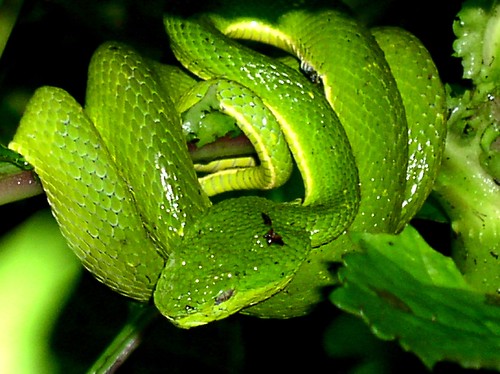Bothriechis lateralis is a venomous pitviper species found in the mountains of Costa Rica and western Panama. No subspecies are currently recognized.
Adult specimens may exceed 100 cm, but are usually less than 80 cm in length. These are relatively slender snakes and have a prehensile tail.
The color pattern consists of an emerald green to bluish green ground color, overlaid with a series of yellow alternating paravertebral vertical bars. Some of the scales adjacent to the yellow in this pattern may be blue or black-tipped.
The belly is a uniform yellowing-green, bordered on either side by a pale yellow stripe running along the lower portion of the paraventral scales and the extreme lateral part of the ventral scales. The head is uniformly green on top and a blue or blue-gray postocular stripe may be present. If a postocular stripe is present, it is weakly defined, especially in large adults. The iris is yellow.
Juvenile specimens are usually brown with dark brown markings on the head, bronze irises, postocular stripes, paravertebral makings that are edged with yellow, and a tail tip that is yellow or chartreuse. Captive juveniles retain this color pattern for about six months, after which the ground color starts to become a dull lime green and the yellow edges of the paravertebral vertical bars more prominent. It is thought that the shift to adult coloration takes about 18-24 months to complete.
Like many green snakes, captive adults tend to become blue over time, although blue specimens are sometimes found in the wild.
Common names : Side-striped palm-pitviper, side-striped palm viper, green palm viper, yellow-lined palm viper.
Found in the mountains of Costa Rica and western Panama, including the Cordillera de Tilarán, the Cordillera Central and the Cordillera de Talamanca to the provinces of Chiriquí and Veraguas. Occurs at 850-980 m altitude. The type locality is listed as "Costa Rica vom Vulcan Barbo [Volcán Barba] ... und .. Veragua" [Panama].


No comments:
Post a Comment